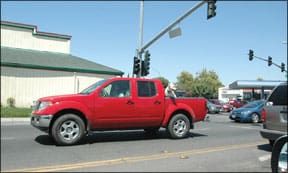Those of us who are a bit older remember when seat belts, air bags, and infant car seats did not exist. Today, these safety devices are mandated by laws and most of us would not consider putting ourselves or our children at risk by not using them in our vehicles. So why do many people still risk the lives of another beloved family member – their dog – by allowing their pet to ride unrestrained in their car or truck?

288
A Lab riding shotgun or loose in the bed of a truck, a Shih Tzu on the driver’s lap, a German Shepherd hanging his head out of the window, a Pomeranian lying up by the back windshield, a Heinz 57-mix pacing on the back seat – we’ve all seen, or even been guilty of, dangerous animal transport practices. “My dog loves to sit on my lap” or “…loves to feel the wind in her face” or “…will only sit in the front seat” or “…would never jump out of the truck,” are all excuses used by owners who subsequently lost their pets tragically in vehicle accidents.
So why don’t many dog lovers safely secure their canine companion in their vehicle? It’s not for lack of loving the animal, but may be attributed to lack of awareness of the dangers of having an unsecured pet in a moving vehicle. It never occurs to many dog owners that their dog needs to be protected in a car; it’s not something that was done with the family dog growing up, and protecting our traveling pets has never been in the forefront of car safety issues. There are no laws for restraining pets in vehicles in most states, and they are woefully inadequate in those states that do have them; most address only the need to secure dogs in the backs of pickup trucks.
Dangerous driving details
The dangers of driving with your dog unrestrained are numerous and hardly hypothetical; in the United States alone, thousands of deaths of dogs, drivers, and passengers are attributed to unrestrained dogs each year, in addition to what must be an unimaginable number of injury accidents and fender benders.
- Even a low-speed crash may turn an unrestrained dog into a missile, possibly ejecting the animal out through the windshield or side window, or perhaps injuring a passenger or driver, resulting in further loss of control of the vehicle. The Automobile Association of America (AAA) estimates that a 10-pound dog will exert approximately 500 pounds of pressure in a 50 mph crash, and an 80-pound dog will exert 2,400 pounds of pressure in a crash at only 30 mph.
- If a dog survives the impact of a crash, he will likely be injured and frightened, and flee the scene, at risk of being struck by another vehicle or becoming lost.
- An unrestrained dog can interfere with driving by crawling on the driver’s lap, falling down by the gas and brake pedals, or creating some other distraction that causes an accident.
- While there are age and weight requirements for children to ride in the front seat of a vehicle, there are no such laws to protect our canine companions. If you have an air bag for the passenger seat of your car, the force of impact upon inflation can severely injure or kill a dog.
- A small dog on the lap of the driver in a crash is at risk of being crushed between the air bag and the driver.
- Dogs riding in the back of pickup trucks can be severely injured or killed by jumping or falling out of the moving vehicle, injured by airborne road debris, and easily ejected upon accident impact.
- A dog who rides with his head outside of a partially opened car window is at risk of injury or loss of an eye from airborne road debris.
- An injured and unrestrained dog can be a danger to any human trying to help. Dogs who are frightened and in pain tend to bite, even their owners.
Statistically speaking
According to AAA, more than 30,000 accidents a year are caused by dogs riding in the front seat of the vehicle. As startling as this number is, it represents only dog owners insured by AAA. One can only imagine the additional high number of accidents due to unrestrained dogs by drivers with other insurers or uninsured.
According to the Travel Industry Association of America, in the U.S., 29 million dog owners drive with their dogs. But only 20 percent use dog safety restraints when traveling (according to the American Pet Manufacturers Association).
A recent online survey conducted by AAA asked dog owners how often they drive with their dogs; it also asked about their driving habits when their dogs were in the vehicle. The results:
- Eighty percent of respondents said they’ve driven with their dogs, but only 17 percent report using a pet restraint.
- One out of three admitted to being distracted by their dog while driving.
- More than half (59 percent) said they have participated in at least one distracting behavior while driving with their dog.
The AAA Foundation for Traffic Safety reports that looking away from the road for only two seconds doubles your risk of being in a crash. Driving with an unrestrained dog can be as distracting as talking on a cell phone or texting. While laws addressing other distracting behaviors when driving have been passed in many states, laws proposed regarding pet restraint inside of vehicles have been routinely rejected.
Totally up to you
Whether through legislation or education, vehicle safety is ultimately up to the individual dog owner. Our dogs can’t protect themselves.
Using a crate is an excellent option for keeping your dog from distracting you, protecting him from injury in the event of a crash, and keeping him secure and contained in the aftermath. Plastic airline crates are best; they help shield the dog from flying shards of glass and unlike metal cages, they don’t collapse easily on impact, causing injury to the dog. A crate should always be secured inside the vehicle to prevent it from flipping or flying forward, as well as in the bed of a truck so it won’t be ejected upon impact.
Dog seat belts, used in the back seat, are another great option to secure your dog in your vehicle to minimize injury in the event of an accident. Available at many pet stores as well as on the Internet, seat belts designed for dogs are harnesses that are secured to the vehicle’s seat belt. Most allow your dog to sit, lie down, or even stand, but otherwise keep the dog in place.
For small dogs, car dog seats or booster seats can elevate your pet so he can see out the window while keeping him restrained for safety. Find one that attaches to the car seat, strapping to the vehicles headrest and seat, or secured by the seat belt, and is equipped with a leash tether to attach to your dog’s harness.
Pet barriers made of steel are intended to keep your dog safely contained behind the front seats. While keeping the dog from physically distracting the driver or crashing through the front windshield from the impact of a crash, other possible dangers are not addressed. The dog may still be ejected from the vehicle, hit by another vehicle, and be a danger to you, or to emergency personnel attempting to help you or your dog. Seat belts are a better option.
And what of the dog who loves to hang her head out a partially opened window? Keep the windows closed; if you feel like you’re depriving your dog of one of life’s simple pleasures, indulge her in another of her favorite pastimes, like a tongue-dragging game of fetch when you reach your destination. She’ll be a safer, healthier dog for it.
Susan Sarubin, CPDT-KA, lives in Easton, Maryland, with her husband and three Rhodesian Ridgebacks. Susan owns Pawsitive Fit, LLC, Puppy and Dog Training, and she is the Maryland State Coordinator for Rhodesian Ridgeback Rescue, Inc.






